Bootstrap Statistics: Computer Science Meets Geoscience
I headed back to class this morning. Only this time, I was fortunate enough to sit in on Dr. Zoet's Computational Techniques for Geoscience 590 course as a student. This graduate level course is designed to help developing geoscientists use computer modeling to aid their research and processing of raw data and samples.
 Dr. Zoet explaining how certain statistical tools are more useful in certain branches of natural science over others.
Dr. Zoet explaining how certain statistical tools are more useful in certain branches of natural science over others.
In today's lesson, I sat next to Geoff as we learned from Dr. Zoet about how Bootstrap Statistics can test for sampling biases in field data. This procedure involves using a computer program called MATLAB to sift through a large set of field data and use common statistical tools to identify any uncertainties or biases. In doing so, MATLAB ultimately computes many thousands of arrangements of the original dataset to identify the strength of the correlation between variables in the original dataset. To quantify the correlation between the variables in the dataset, the MATLAB program utilizes some common statistical tools: Pearson's Linear Trend, Kendall's Tau, or Spearman's Rho. IB students, will you be learning about these in your IB Math Studies courses at all?
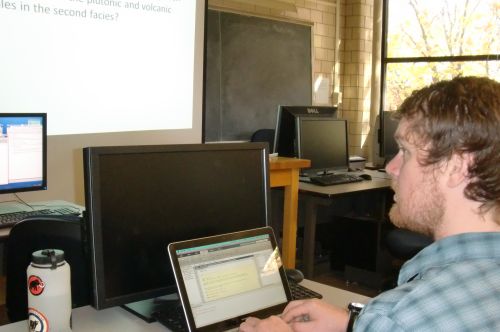 Geoff awaits his next MATLAB computer modeling assignment from Dr. Zoet.
Geoff awaits his next MATLAB computer modeling assignment from Dr. Zoet.
Dr. Zoet had the class practice these new Bootstrap Statistics in MATLAB using a rock facies (rock units) dataset from the Inklin Formation congolmerates in British Columbia. Conglomerates are a type of sedimentary rock that are composed of many other different types of rock fragments that have been cemented together. Students created box plots, histograms, and other statistical models in MATLAB for this data set as practice. Dr. Zoet utilizes DropBox to get these datasets to his students at their computers. They can then import this data into MATLAB from the DropBox folder.
All in all, the goals of this course are broad, comprehensive, and provide each student with a toolbox of skills in computer modeling that can be used across geoscience disciplines for research and data analysis. The final component of this course will allow each student to apply what they have learned using MATLAB to their own research. Geoff is excited to use MATLAB in his research from Mulajokull to examine the magnetic fabrics in his AMS samples in much greater detail and with much higher precision.
Welcome to Neal's Lab!
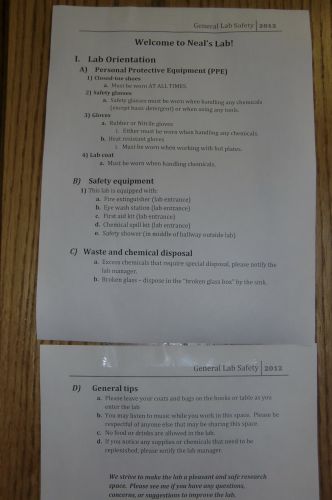 See class!? All of those days we spend in the beginning of each semester learning about laboratory safety really DO become useful in the college setting!
See class!? All of those days we spend in the beginning of each semester learning about laboratory safety really DO become useful in the college setting!
After class with Geoff and Luke, I joined Reba and Dr. Iverson in their lab for a quick tour and some troubleshooting on calibrating probes for the consolidometer; the device that the team is using to analyze the Pre-Consolidation samples. Right now the digital component that the device uses to measure stress needs recalibrating before Mulajokull samples can be put through the device, so Neal and Reba are working to get the electronics up and running again.
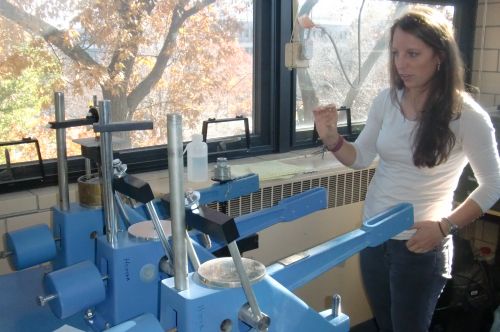 Reba explained how the consolidometer works to help the team determine the total effective stress that was experienced by our till samples while still under Mulajokull's massive ice mass.
Reba explained how the consolidometer works to help the team determine the total effective stress that was experienced by our till samples while still under Mulajokull's massive ice mass.
Here's the deal: the consolidometer applies increasing increments of pressure to a till sample using small brass weights. At first, this squeezes the till elastically; it could return to its initial shape if the stress was removed. Once the till has overcome the magnitude of pressure that was previously exerted on the till from the glacier, it will deform permanently; not able to return to its initial shape if the sress was removed. These data for stress help the team determine the overlying pressures that were once exerted on till at the base of Mulajokull during its last surge/advance. The team can then make safe inferences about which of the competing drumlin hypotheses are supported by these data.
 Pre-Consolidation Testing is a common technique used by structural engineers when assessing building sites. Here, Reba references an engineering text to seek support for further understanding how the total effective stress is determined using this tool.
Pre-Consolidation Testing is a common technique used by structural engineers when assessing building sites. Here, Reba references an engineering text to seek support for further understanding how the total effective stress is determined using this tool.
The centerpiece of Neal's lab is most certainly the Ring Shear Device. The first of these devices was constructed by Neal in the late 1990's, and allows scientists to model how glacial till behaves under various amounts of shear stress at the base of glacial ice. The device can also be used to shear ice itself, and model how it behaves under varying degrees of shear stress. Neal's development of this device was a highly significant improvement in laboratory glaciology, and allows for a wide variety of experiments on glacial flow dynamics and basal till deformation to be completed using it.
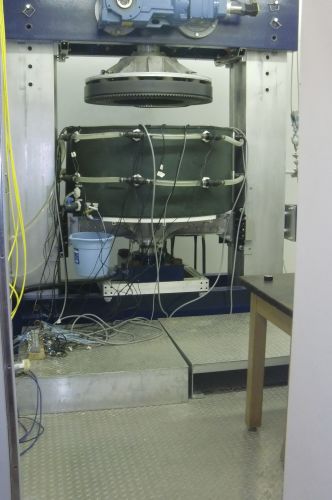 Dr. Iverson's ring shear device in his lab.
Dr. Iverson's ring shear device in his lab.
 Here I am checking out the mechanics of the device. Dr. Iverson explained to me how the hyrdaulic lift pushes samples of ice or till into the ring plate above, and then rotates to simulate shear stress at a glacier's base.
Here I am checking out the mechanics of the device. Dr. Iverson explained to me how the hyrdaulic lift pushes samples of ice or till into the ring plate above, and then rotates to simulate shear stress at a glacier's base.
 A look into the inside of the ring shear device.
A look into the inside of the ring shear device.
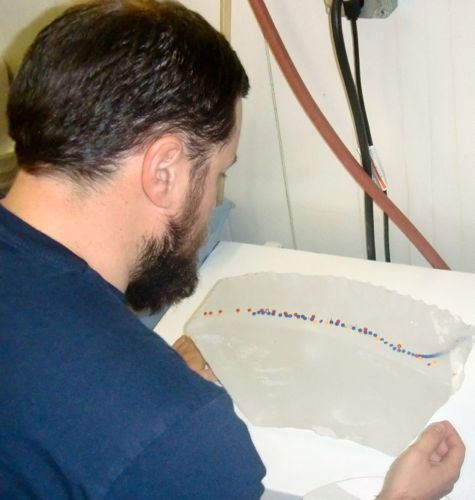 Dr. Zoet showed me a sample of his glacial ice model that he recently put through the ring shear device. The plastic beads suspended in the ice were initially in a vertical line. The device has sheared the ice over the course of about a month, causing the beads to migrate in the direction of the preferential shear stress.
Dr. Zoet showed me a sample of his glacial ice model that he recently put through the ring shear device. The plastic beads suspended in the ice were initially in a vertical line. The device has sheared the ice over the course of about a month, causing the beads to migrate in the direction of the preferential shear stress.
 A close up of part of Luke's model from the his ring shear tests. The blue beads help determine shear stress, and the red and yellow beads help measure the rate of shear and deformation of the ice.
A close up of part of Luke's model from the his ring shear tests. The blue beads help determine shear stress, and the red and yellow beads help measure the rate of shear and deformation of the ice.
Presentation for the Iowa Science Center
To finish off our first day back together, we delivered a talk about our team's work at Mulajokull at Java Joe's in neighboring Des Moines, Iowa. The talk was part of the Iowa Science Center's monthly Cafe Sci community science talks, and they featured our team's work with drumlins and educational outreach in public schools via PolarTREC. It was a very successful event and we enjoyed getting out in the community!
 Here Neal explains why understanding how glaciers respond to global warming is of such high value to not only the scientific community, but global societies as well.
Here Neal explains why understanding how glaciers respond to global warming is of such high value to not only the scientific community, but global societies as well.
 Reba, Geoff, and I working with the audience members at the presentation. We had them model the microscopic magnetic till particles in AMS samples as we may expect them to be arranged in the two leading hypotheses for drumlin formation. Photo Credit: Science Center of Iowa.
Reba, Geoff, and I working with the audience members at the presentation. We had them model the microscopic magnetic till particles in AMS samples as we may expect them to be arranged in the two leading hypotheses for drumlin formation. Photo Credit: Science Center of Iowa.
We head out to Milwaukee next to meet the other half of the team. I am excited to finally check out how AMS samples are analyzed in the lab up there, and am even more excited to Skype with my students back home to show them the AMS lab.
Feel free to post any questions using the Ask the Team forum!
Cheers,
Jamie

